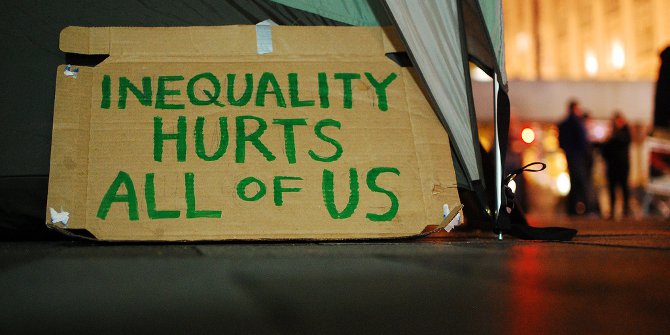
 COVID-19 has not affected everywhere in the US equally, there are significant disparities in Covid-related illnesses between the states. In new research which analyses the relationship between COVID-19 and economic, social and demographic factors, Harold Clarke and Paul Whiteley find that those states with greater income inequality are more likely to see coronavirus cases and related deaths.
COVID-19 has not affected everywhere in the US equally, there are significant disparities in Covid-related illnesses between the states. In new research which analyses the relationship between COVID-19 and economic, social and demographic factors, Harold Clarke and Paul Whiteley find that those states with greater income inequality are more likely to see coronavirus cases and related deaths.
The United States has more reported cases of COVID-19 and more deaths from the virus than any other country in the world. So far, over one million Americans have contracted the disease and nearly 70,000 have died. The incidence of Covid-related illness varies widely across the states with the number of people infected ranging from over 100,000 in New York to less than 400 in Alaska. Differences in economic inequality are important for explaining these highly divergent health outcomes.
In 2014 the French economist Thomas Piketty published a widely cited book, Capital, which showed that economic inequality has increased markedly since the early 1970s in the US and many other countries. Reacting to Piketty’s findings researchers have shown that inequality has many undesirable effects including significant negative impacts on public health, and the COVID-19 crisis is a case in point.
We gathered data on the number of Covid cases and fatalities in each state and developed a statistical model of the impact of economic inequality and other possibly influential factors on the pandemic. We assess economic inequality with the Gini Index, a standard measure which varies from 0 (total inequality) to 1 (total equality). Although economic inequality is considerably greater in the US than in other major Western democracies such as Great Britain, France and Germany, the extent of inequality also differs significantly across states within the US. For example, in 2018 the Gini varied from a low of .43 in Alaska and Utah to a high of .52 in the District of Columbia and New York.
Investigating the impact of inequality on the incidence of Covid in various states needs to take into account other potentially influential factors. Most obvious is population size – other things equal, large states can be expected to report more cases and fatalities than small states. Population density matters as well since inter-personal transmission of the virus will be higher in densely populated areas. Also, older people, especially those over 65, are more vulnerable to the disease.

“DSC_8882” by Dean Chahim is licensed under CC-BY-NC-SA-2.0.
The size of minority populations (African-American, Hispanic) is relevant too. People in these groups frequently are employed in blue-collar and service occupations that involve close contact with others which increases their exposure to the virus. In addition, ethnic minorities are more likely to suffer from co-morbidities such as asthma, diabetes, obesity and cardiovascular disease that make the impact of the disease particularly debilitating and possibly fatal.
The overall health and well-being of a state’s population also is important. We measure this using the Human Development Index (HDI) which combines information on educational attainment, annual income and longevity. The quality of a state’s health care system is relevant as well and so we control for that.
Our analyses show that several factors affect the number of Covid cases and also deaths. Although the percentages of African Americans and Hispanics and the over 65s do not have significant direct effects, states with larger and more dense populations have more Covid cases. Figure 1 shows that this is true for deaths as well where the coefficients measure the size of the impact of different variables on fatalities. In contrast, states with superior health care systems and higher levels of human development have experienced fewer cases and fatalities.
Figure 1 – Strength of Predictors of COVID-19 Fatalities

All these factors aside, states with greater income inequality are more likely to report more COVID-19 cases and fatalities. The effect of inequality is large – it is tied with the Human Development Index as the second strongest predictor of Covid deaths in various states. Figure 2 shows that the predicted number of cases in a state grows nearly seven-fold, from 2368 to 14,618, if the level of economic inequality increases from its lowest to its highest observed level. Similarly, the number of deaths climbs from 65 to fully 723 as economic inequality increases.
Figure 2 – Predicted State-Level COVID-19 Cases as Income Inequality Increases

These large predicted effects of inequality are statistically robust. Including other possible predictors such as whether a state has a Democratic or Republican governor does not change effects. In addition, the results remain strong if we exclude states like New York or New Jersey that have experienced very high levels of cases and fatalities.
The fact that minority populations do not directly affect the number of cases or fatalities can be understood by noting that African American and Hispanic populations tend to be concentrated in states with higher levels of economic inequality. Members of these groups are more likely to experience negative health effects associated with greater inequality and these effects drive the incidence and seriousness of the illness.
Minorities are not alone – economic inequality works to increase the incidence and impact of COVID-19 among all segments of the US public. Although the future course of the Covid crisis is uncertain, state-level differences in inequality are working to define how the pandemic will unfold across America in the months ahead.
Please read our comments policy before commenting.
Note: This article gives the views of the author, and not the position of USAPP – American Politics and Policy, nor the London School of Economics.
Shortened URL for this post: https://bit.ly/2YBl31T
About the authors
 Harold Clarke – University of Texas at Dallas
Harold Clarke – University of Texas at Dallas
Harold D. Clarke, Ph.D. Duke University is Ashbel Smith Professor, School of Economic, Political and Policy Sciences, University of Texas at Dallas, and Adjunct Professor, Department of Government, University of Essex.
 Paul Whiteley – University of Essex
Paul Whiteley – University of Essex
Paul Whiteley is a Professor in the Department of Government at the University of Essex. His research interests are in electoral behaviour, public opinion, political economy and political methodology.






